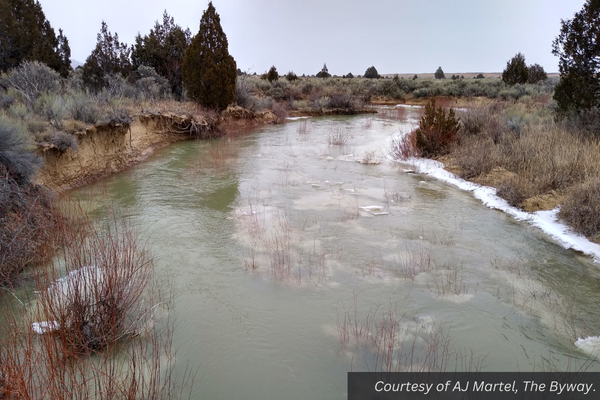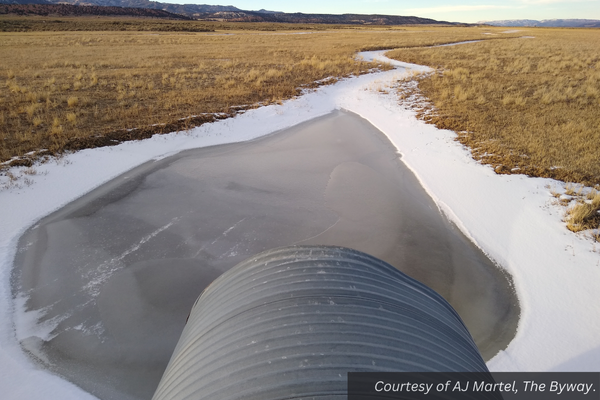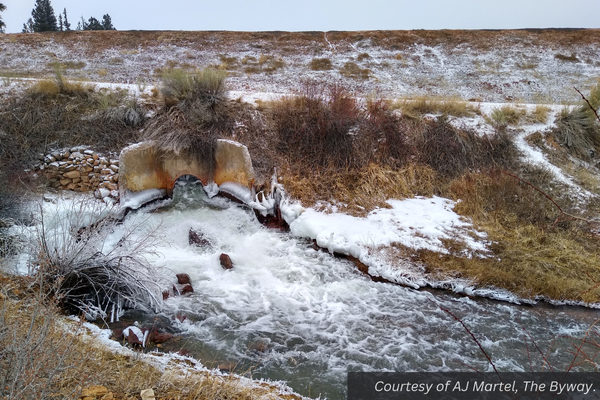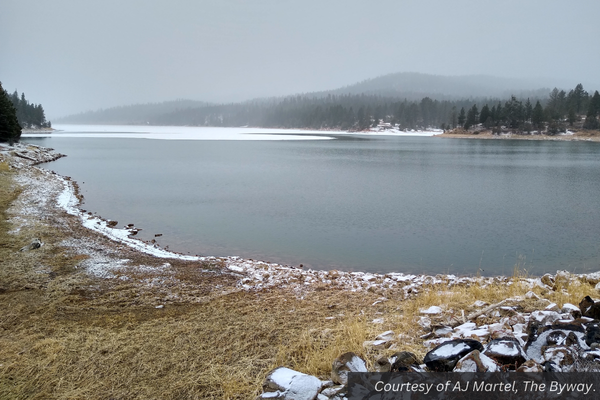Bryce Valley’s irrigation company was thrown into chaos in early February after a state engineer challenged the company’s right to store water in Tropic Reservoir before May 1.
In a letter obtained by The Byway, Utah Division of Water Rights Regional Engineer Terry Monroe directed Tropic & East Sevier Irrigation Company (TESIC) to immediately stop impounding water in Tropic Reservoir, and release stored water down East Fork Sevier River to Otter Creek Reservoir.
Tawn Mangum, president of TESIC, opened the Tropic Reservoir floodgate wide on February 7 and water could soon be seen in the East Fork Sevier flowing under Highway 12. Even a week later, however, none of that water had made it the 17 miles down to Johns Valley Landfill Road, let alone the 50 miles to Otter Creek Reservoir.


Some locals see this as another attack on Upper Sevier River water users from users downstream, particularly those in Delta. Delta’s conglomeration of irrigation companies, DMADC, has for the last few years aggressively protested users in the Panguitch area, protesting water right change applications and challenging South Fork Sevier users for not actually using their water — under the use-it-or-lose-it doctrine.
Delta water users have a right to any Sevier River water that is not appropriated upstream.
Yet Terry Monroe’s letter is not a protest by downstream users, but an official act of the State of Utah. Monroe states that Tropic Reservoir must discharge the water according to the Sevier River Decree and a court stipulation from 1946.
As it stands, Bryce Valley water users may be up a creek without a paddle — and without a creek.
“They are in a panic because Tom Mangum had three-quarters of the reservoir filled,” Garfield Commissioner Leland Pollock said, worried about little spring runoff this year. “Now it will likely be empty by May.”
Even after the February storm following the state’s order, the Paunsaugunt only logged a snowpack at 25% of normal.
Before 1961, TESIC had the right to store only 540 acre-feet of water in Tropic Reservoir, which can hold as much as 1,680 acre-feet of water at full pool. Originally, Tropic could only collect that water between May 1 and October 15, after the spring runoff had already occurred.
In 1961, however, Otter Creek Reservoir Company (OCRS) signed an agreement with TESIC to store up to 3,000 acre-feet of its own water in Tropic Reservoir between October 15 and April 15. According to the agreement, whenever the reservoir would reach full pool, they would release all the stored water to Otter Creek Reservoir in batches. The idea was that if the water flowed in large enough batches, more of it would make it down the East Sevier rather than sinking into Johns Valley.
In 1977, OCRS filed a water change application with the state to make official the 1961 agreement. TESIC actually protested the change application, worried it would turn Tropic Reservoir over to the control of OCRS and that it would hinder TESIC’s own storage right in the reservoir.
Yet, it was that very agreement with OCRS that allowed TESIC to store spring runoff water in Tropic Reservoir all these years.
In 2005, Division of Water Rights extended OCRS’s 1977 change application. In 2010, however, the division notified OCRS that they had until August to “proof-up” their change application, or the storage right would lapse. It is not clear whether OCRS simply did not respond to the division out of neglect, or whether they voluntarily chose to let the change application lapse. But in August of that year, the division sent OCRS a final notice of permanent lapsing.
Now in 2025, it appears the division is finally addressing the fact that Tropic Reservoir is still storing water through the winter months.

“We’re at our wit’s end,” Pollock told The Byway on February 14. “We’ve received a request from [TESIC] to declare a state of emergency.” Pollock has appealed to Governor Spencer Cox for help, but he fears even the governor may be powerless to solve the problem.
Later that same day, the Garfield commissioners held a meeting to discuss a possible emergency declaration. Pollock noted that after a conversation with Division of Water Rights State Engineer Teresa Wilhelmsen, the state had asked the county to hold off on declaring a state of emergency to see if OCRS and TESIC could work something out.
“We need something done in three days or we will meet again,” David Tebbs suggested. “We need to give them a deadline or we will lose a third of the lake.” But it was the Presidents’ Day long weekend. The commissioners decided not to declare an emergency but suggested they meet the following Wednesday (Feb. 19) if the problem had not been resolved.
At the time, Tawn Mangum was hopeful. “Matt Mills [president of OCRS] is willing to talk, and said he’ll do what he can to help,” Mangum told us. There was also a question of whether an old agreement between the two irrigation companies might prove to the state that the storage right still rested at Tropic Reservoir. That 1961 agreement, however, had been drawn up and signed on an old brown paper bag. “We haven’t been able to find it yet,” Mangum said.
The following week, Mangum found an old photocopy of the brown paper bag agreement, along with two big boxes and a briefcase of other old TESIC documents.
Hope is dwindling on this path, however. On February 19, no emergency was declared and the two companies have not been able to find something to agree on. As it stands, OCRS is not interested in renewing the 1961 agreement or drawing up a new agreement to continue storing its water in Tropic Reservoir.
Regardless of the agreement, however, the state may argue that without a bona fide, approved change application (like the 1977 one), an agreement between OCRS and TESIC would be moot anyway. And even if OCRS wanted to file a new change application, an increasingly aggressive DMADC downstream would no doubt fight it.
TESIC will only be able to store 540 acre-feet in Tropic Reservoir, and can only collect that during the summer months when water is already in high demand. During those months, Mangum estimates that only eight or nine cubic feet per second flows into the reservoir, while at the same time he is supposed to turn 15 or 20 cfs over the hill to Bryce Valley.
Both Mangum and the Garfield commissioners still hope to find a creative solution, but so far they are only finding roadblocks. Going forward, Bryce Valley will likely look drier and, depending on water availability, may only be able to irrigate half or two-thirds of its arable ground.
– The Byway
Feature image caption: Tropic Reservoir, seen just before a storm on February 13, was estimated to be 75% full when TESIC was ordered to release all its water.
Read more about Garfield Commissioners and water in What Do Commissioners Mean When They Talk about Water Conservation?

